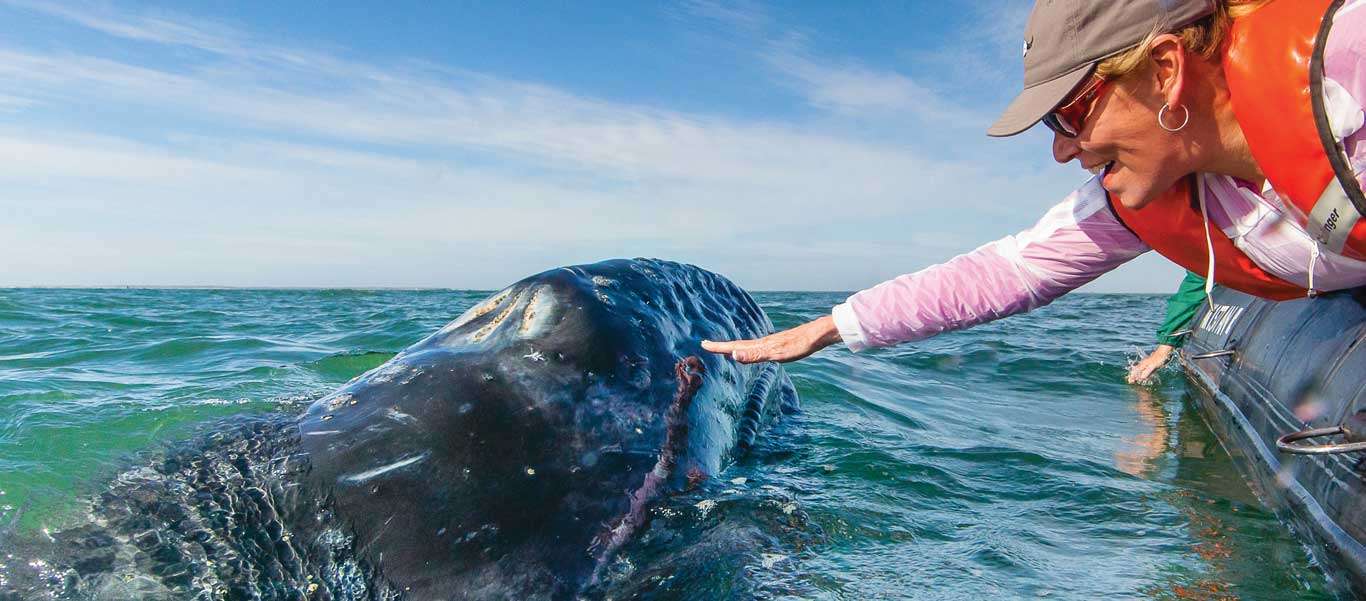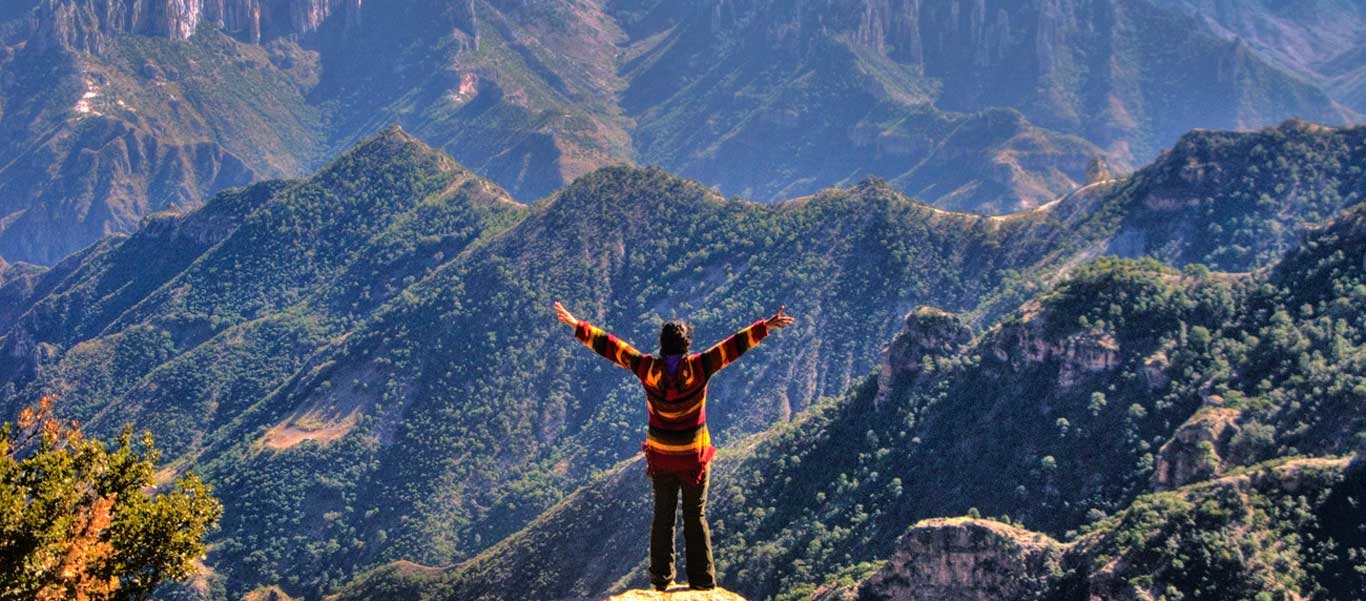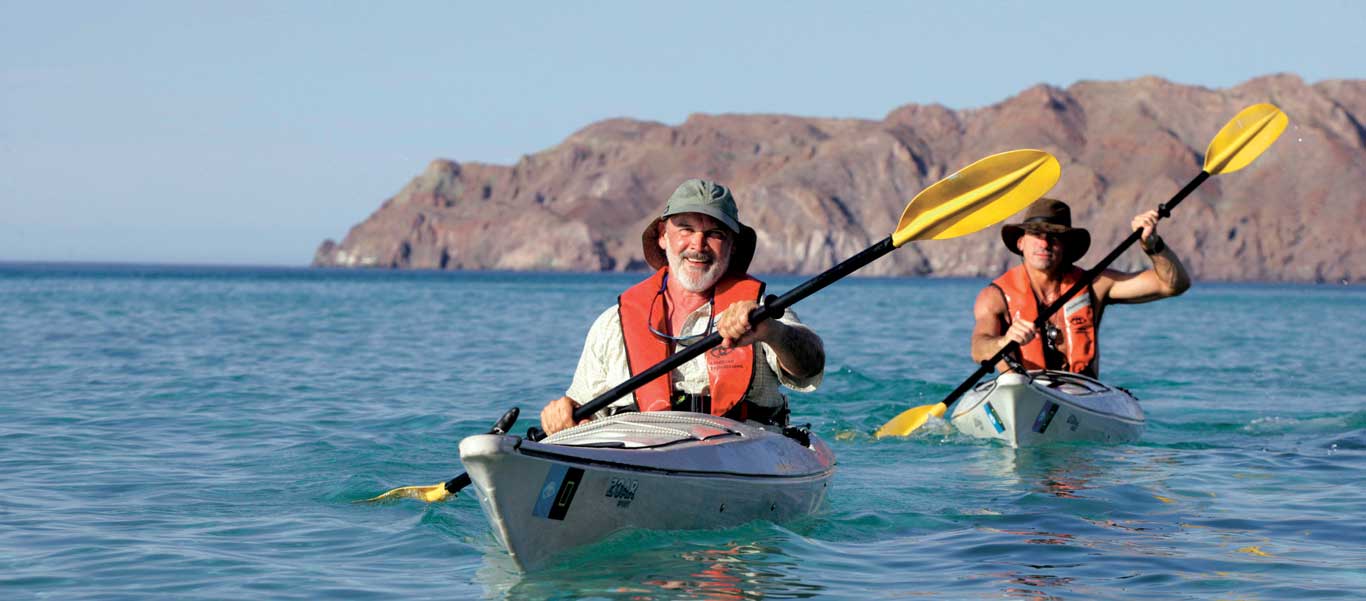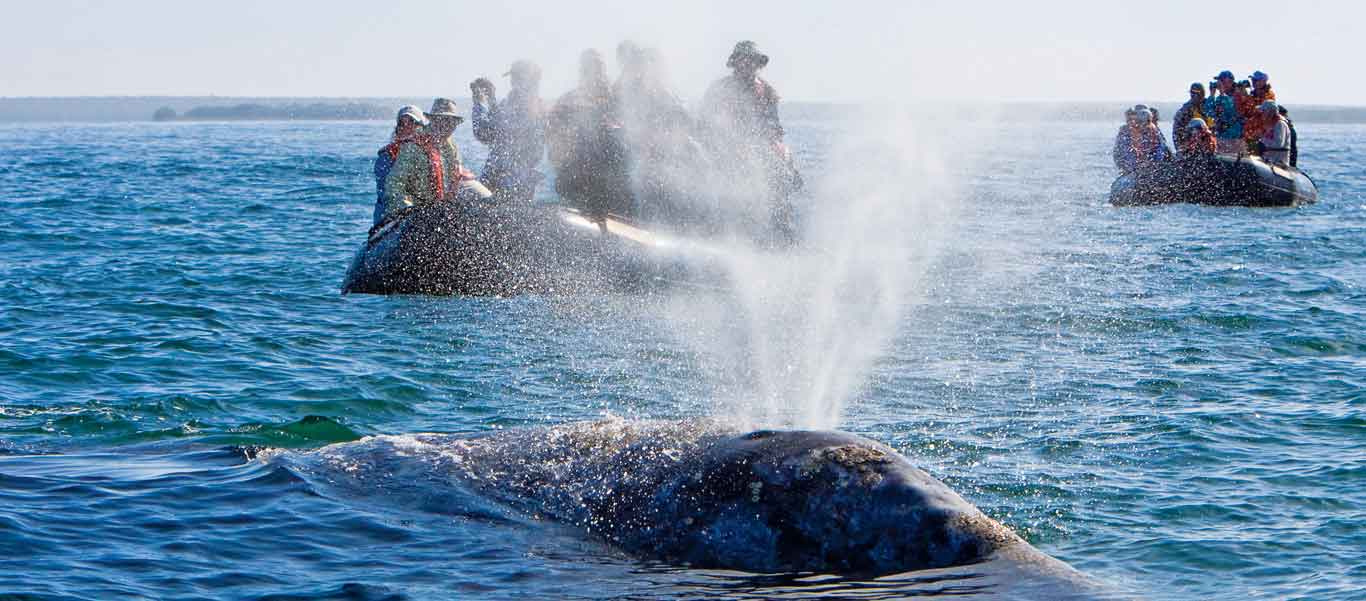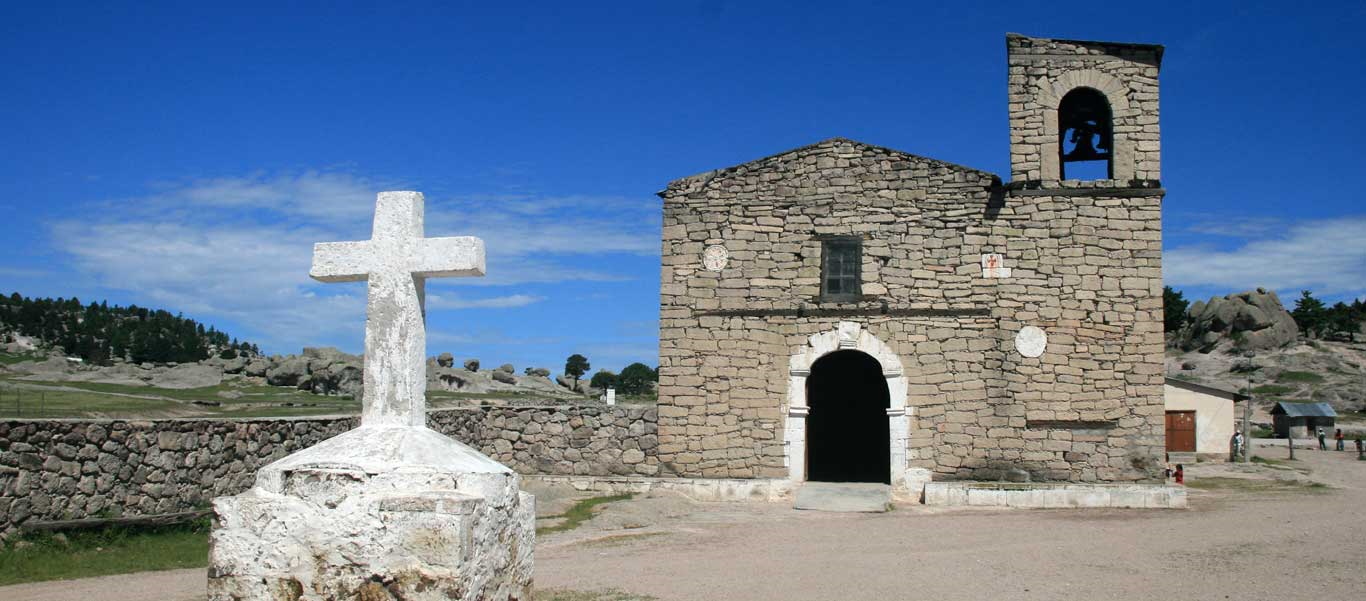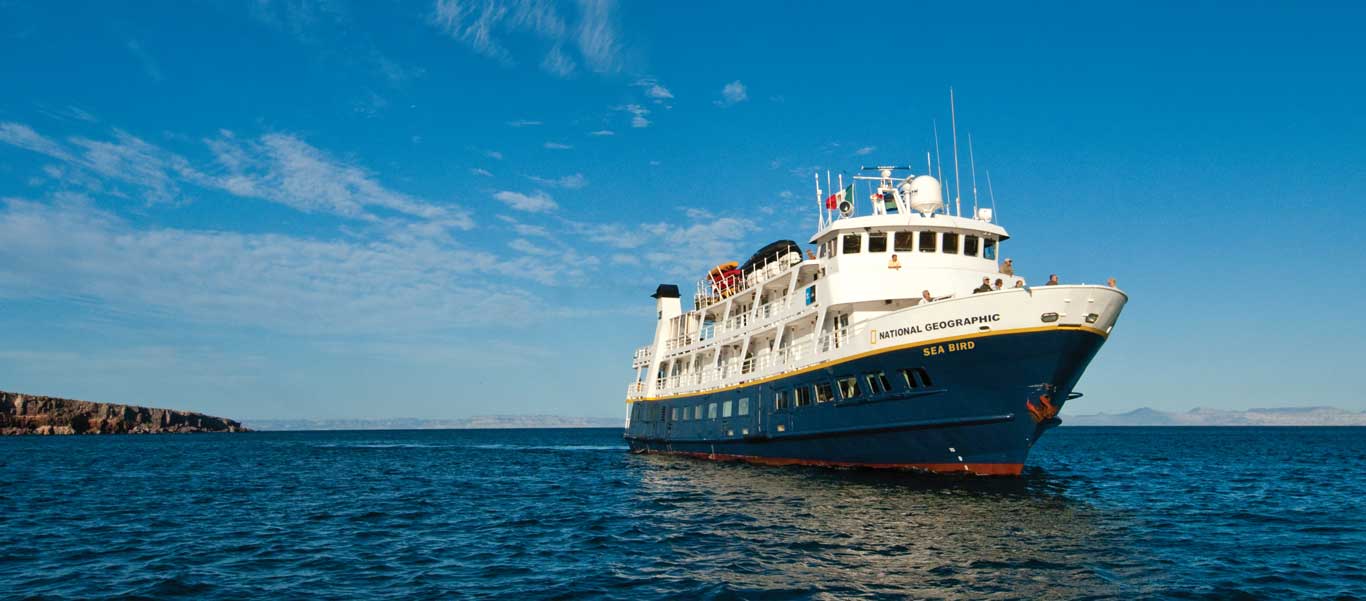Sea of Cortez with Copper Canyon
onboard National Geographic Sea Bird
Baja Whale Watching Cruise with Copper Canyon
Get up close and personal with two marvels of nature on this Mexico adventure—Baja whale watching in the Sea of Cortez and Copper Canyon’s stunning scenery. Commune with monoliths of the ocean, California Gray Whales, as they breed and birth their young in the sheltered Baja waters. Hike desert islands and explore the marine-rich Sea of Cortez as you snorkel and kayak with sea lions, whales and dolphins. On the second leg of this adventure, descend deep into the Copper Canyon. Appreciate the vastness of this region via the epic Chepe railway, then descend to the historic village of Batopilas on the canyon floor for a glimpse into the region’s silver mining past, and encounter the fascinating native Rarámuri people along the way. With Apex’s expert leader, Kevin Clement, you’ll experience the varied and spectacular terrain of Mexico’s Sierra Madre Occidental Mountains.
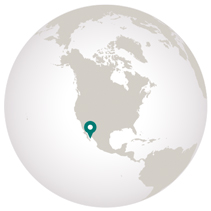
Destinations
- Travel by Air
- Travel by Road
- Travel by Boat
- Travel by Bullet Train
- Travel by Rail
- Travel by Dog Sled
-
Friday, February 3: Arrive San José del Cabo, Mexico
Arrive in San Jose del Cabo and transfer to the quiet colonial city center. Explore the Plaza Mijares and Iglesia San José Church, on your own, before enjoying a welcome dinner with your expedition leader and fellow travelers. Overnight at El Encanto Inn & Suites.
-
Saturday, February 4: La Paz / San Carlos / Embark National Geographic Sea Bird
After breakfast transfer to La Paz where you will join additional voyage guests for the transfer to the beach town of San Carlos to embark your ship, the National Geographic Sea Bird. Settle into your cabin before heading up on deck to meet your expedition crew and captain. Toast to the adventures ahead as you sail off the tip of the peninsula and embark on an exhilarating Baja whale-watching cruise down the Pacific coast.
-
Sunday–Tuesday, February 5–7: Bahía Magdalena
Bahía Magdalena is comprised of an immense network of protected coves and inlets, with mangrove channels at one end and a vast, windswept plain at the other. It is also one of the main breeding and calving areas for the California Gray Whale, and therefore an ideal spot for whale watching in Mexico. While we would never presume to predict Nature’s behavior, it is highly likely that you will have the privilege of an up-close and personal sighting. Enjoy this opportunity as the expert crew guide you out in kayaks and expedition landing craft to attempt “friendly encounters” with mother and calf pairs. Bird watching can also be excellent here—Magnificent Frigatebirds, pelicans, terns, Great Blue Herons, ibis and Willets abound.
-
Wednesday, February 8: Los Cabos and Gordo Banks
Cruise past the spectacular Land’s End at the very tip of the peninsula—watch sea lions lazing on large rocky outcroppings shaped like hooded monks (hence their name, Friars Rocks). Spend the afternoon in the gateway to Baja’s Sea of Cortez, thought to be one of the most diverse seas on the planet. At the Gordo Banks seamount or La Fortuna, keep a look out for Humpback Whales, which are commonly seen this time of year. Look for their signature tail lobbing, flipper slapping and breaching. The area is also a gathering place for dolphins.
-
Thursday, February 9: Los Islotes and Isla Espiritu Santo
Visit two of the most beautiful islands in the Sea of Cortez. Los Islotes’ deeply indented shores and dramatically eroded cliffs are home to many California Sea Lions, and you will have the opportunity to snorkel with these highly habituated pinnipeds. Bold pups may swim right up to your mask for a closer look. As you approach Isla Espiritu Santo, you may spot Blue-footed Boobies or Brown Pelicans skimming the turquoise sea. Isla Espiritu Santo is one of the most unspoiled ecosystems in Baja, boasting the endemic Black Jackrabbit and Espiritu Santo Antelope Squirrel, as well as Ring-tailed Cat. Observe the impressive geological past of these islands from a kayak: see tons of compacted volcanic ash covered with solidified lava floods just yards from the shore. Finish the day with a beach barbecue complete with campfire and a star-filled sky.
-
Friday, February 10: Exploring the Sea of Cortez
Enjoy the luxury of a day with no specific plan. Explore the islands of the southern Sea of Cortez, one of the best areas in Baja for Blue Whale watching and for spotting Common and Bottlenose Dolphins. Walk among huge cacti and look for diverse gulls, terns and murrelets on the uninhabited Isla San José or Isla Santa Catalina. Swim or snorkel with King Angelfish, butterflyfish, damselfish and beautiful parrotfish.
-
Saturday, February 11: La Paz / El Fuerte
Bid a fond farewell to the ship today and head to La Paz airport for a short flight across the Sea of Cortez to Los Mochis, in Sinaloa Province. On arrival, transfer to the colorful, 16th-century town of El Fuerte. Meet your local guide at dinner to discuss your next few days of touring the Copper Canyon, a labyrinth of seven main canyons covering an area four times larger, and considerably deeper in places, than Arizona’s Grand Canyon. Overnight at the beautiful Posada del Hidalgo, located just below the magnificent old fort from which the town got its name.
-
Sunday, February 12: El Fuerte / Posada Barrancas
Hop aboard the Copper Canyon train, El Chepe (Chihuahua-Pacific Railway), perhaps Mexico’s greatest engineering feat, which connects the region via 80 tunnels and nearly 40 bridges, with astonishing vistas at every turn. Disembark in Divisadero to explore the canyon rim by foot. Enjoy dinner and overnight at Hotel Mirador, poised near the highest point of the canyon rim with majestic sunset views.
-
Monday, February 13: Posada Barrancas
Enjoy breakfast at the hotel before heading into the heart of the Copper Canyon. Take a cable car ride across Urique, the largest of seven canyons, and walk around the mesa in the middle of the canyon to see the Urique River far below. Learn about the geology of the area, as well as the native Rarámuri inhabitants. The second-largest indigenous group in North America, the Rarámuri are known for their long-distance running, or “foot throwing”, which is their standard form of transportation in this vast and rugged landscape. Return to the hotel for dinner and overnight.
-
Tuesday, February 14: Posada Barrancas / Batopilas
After breakfast, load up in vehicles for a jaw-dropping drive down to the bottom of Batopilas Canyon. Travel through three different climate zones, descending from over 7,500 feet to about 1,300 feet at our destination, the sleepy, old, silver-mining village of Batopilas. En route, see the massive black rock spires of the Valley of the Monks, and the appropriately named Valley of the Frogs near the San Ignacio Mission, and stop for views of Buffleheads, Ring-necked Ducks and Blue-winged Teals at Lake Arareco. Continue winding through the immense canyon systems that the Rarámuri peoples call home, to the charming town of Batopilas. Dinner and overnight in the beautiful old hacienda, the Riverside Lodge.
-
Wednesday, February 15: Batopilas
Explore Batopilas and learn of its colorful silver mining history. Visit the Lost Cathedral of Satévo, framed in a forested river gorge just downstream from Batopilas. In town, see the castle-like ruins of Hacienda San Miguel, once owned by Alexander Shepherd, the American ‘Silver Magnate’ of the region. The Batopilas Museum offers up a good overview of the town’s history, the mining era and ‘The Silver Trail.’ This afternoon, enjoy a walk along the old aqueduct, built by Shepherd to generate electricity and supply his factory with water. It made Batopilas the second town in all of Mexico to have electricity. Look out for such colorful birds as Russet-crowned Motmots, Black-throated Magpie Jays, Flame-colored Tanagers, and Mexican Parrotlets, as well as hummingbirds and four kinds of trogons that nest here. Overnight at the Riverside Lodge.
-
Thursday, February 16: Batopilas / Creel
Bid farewell to the Copper Canyon floor and return to Creel stopping to see anything we may have missed on the way down. One such stop will be the Cusárare Mission, a beautiful 18th-century Jesuit church painted by indigenous craftsmen. Next door to the mission, traditional art can be found in the Loyola Museum which has more than 40 oil paintings of saints and other religious icons by Mexican masters. Enjoy lunch in Creel before a walk to the main plaza in town. Dinner and overnight at the Best Western Hotel.
-
Friday, February 17: Creel / Candaména Canyon / Chihuahua
After an early breakfast, depart for Candameña Canyon and the 800-foot Basaseachi Falls, or “Place of the Coyotes” in the Rarámuri language. This is Mexico’s tallest continuously-running waterfall. A pristine, high desert pine forest clings to the steep gorge, and volcanic tufa towers jut out at all angles along the rim. Coyotes, rattlesnakes, Black Bear, vultures, Bobcats and Cougars call this inhospitable place home. There are many footpaths and viewpoints along the cliff, and more strenuous hiking trails to choose from. Continue on to Chihuahua, the quirky capital of Mexico’s biggest state. Enjoy a city tour to see the beautiful murals on the municipal building, a museum housed in Pancho Villa’s former mansion, and the main Cathedral. Celebrate your Baja whale watching and Copper Canyon adventure with a farewell dinner in town. Overnight at the Sheraton Soberano Hotel.
-
Saturday, February 18: Depart Chihuahua
After breakfast, transfer to the Chihuahua airport for your international flights home.

